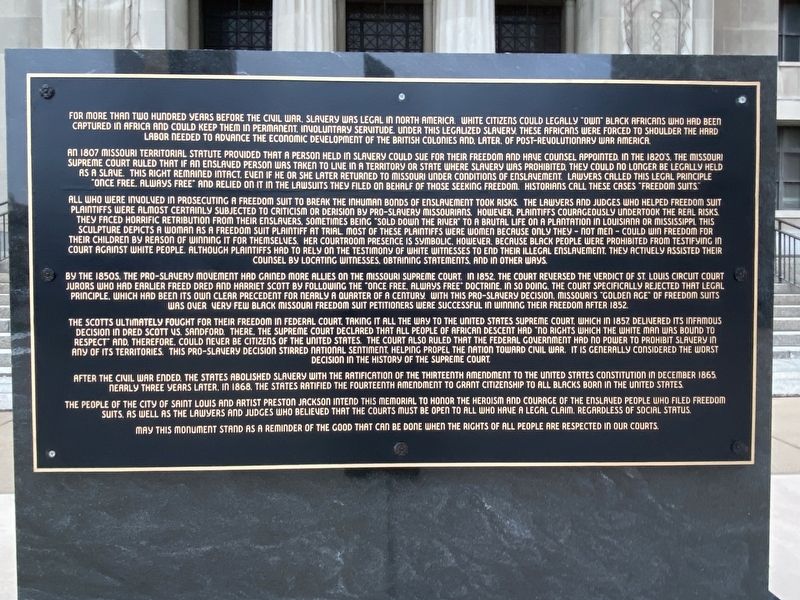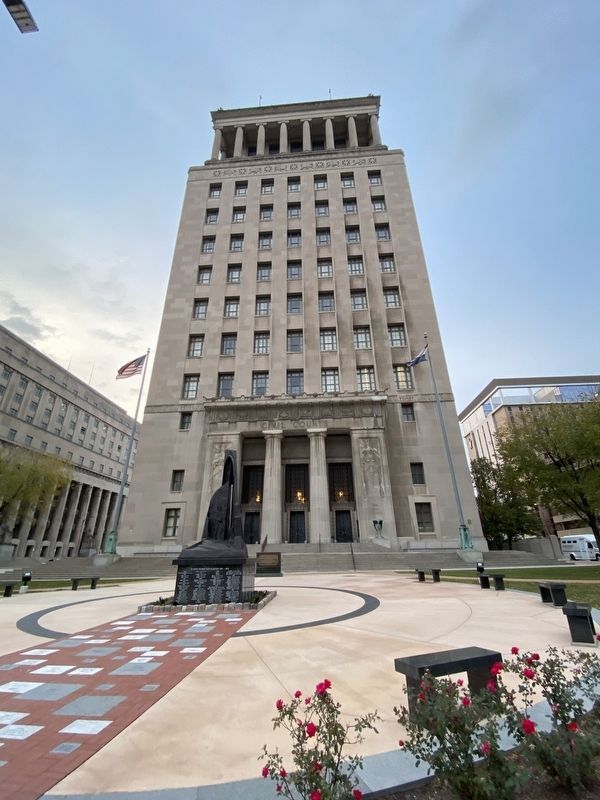Downtown in St. Louis, Missouri — The American Midwest (Upper Plains)
Memorial to the heroism and courage of enslaved people who filed freedom suits
Inscription.
For more than two hundred years before the civil war, slavery was legal in North America. White citizens could legally "own" Black Africans who had been captured in Africa and could keep them in permanent, involuntary servitude, under this legalized slavery. These Africans were forced to shoulder the hard labor needed to advance the economic development of the British colonies and later, of post-Revolutionary War America.
An 1807 Missouri territorial statute provided that a person held in slavery could sue for their freedom and have counsel appointed in the 1820's. The Missouri Supreme Court ruled that if an enslaved person was taken to live in a territory or state where slavery was prohibited, they could no longer be legally held as a slave. This right remained intact, even if he or she later returned to Missouri under conditions of enslavement. Lawyers called this legal principle "once free, always free" and relied on it in the lawsuits they filed on behalf of those seeking freedom. Historians call these cases "Freedom Suits."
All who were involved in prosecuting a Freedom Suit to break the inhuman bonds of enslavement took risks. The lawyers and judges who helped freedom suit plaintiffs were almost certainly subjected to criticism or derision by pro-slavery Missourians. However, plaintiffs courageously undertook the real risks. They faced horrific retribution from their enslavers, sometimes being "sold down the river" to a brutal life on a plantation in Louisiana or Mississippi. This sculpture depicts a woman as a freedom suit plaintiff at trial. MOst of these plaintiffs were women because only they - not men - could win freedom for their children by reason of winning it for themselves. Her courtroom presence is symbolic, however, because Black people were prohibited from testifying in court against white people. Although plaintiffs had to rely on the testimony of white witnesses to end their illegal enslavement, they actively assisted their counsel by locating witnesses, obtaining statements, and in other ways.
By the 1850s, the pro-slavery movement had gained more allies on the Missouri Supreme Court. In 1852, the court reversed the verdict of St. Louis circuit court jurors who had earlier freed Dred and Harriet Scott by following the "once free, always free" doctrine. In doing so, the court specifically rejected that legal principle, which had been its own clear precedent for nearly a quarter of a century. With this pro-slavery decision, Missouri's "Golden Age" of freedom suits was over. Very few Black Missouri freedom suits petitioners were successful in winning their freedom after 1852.
The Scotts ultimately fought for their freedom in Federal Court,
taking it all the way to The United States Supreme Court, which in 1857, delivered its infamous decision in Dred Scott vs Sanford. There, the Supreme Court declared that all people of African descent had "no rights which the white man was bound to respect" and therefore, could never be citizens of The United States. The court also ruled that the federal government had no power to prohibit slavery in any of its territories. This pro-slavery decision stirred national sentiment, helping propel the nation toward civil war. It is generally considered the worst decision in the history of the Supreme Court.
After the Civil War ended, the states abolished slavery with the ratification of the thirteenth amendment to the United States Constitution in December 1865. Nearly three years later, in 1868, the states ratified the fourteenth amendment to grant citizenship to all Blacks born in the United States.
The people of the city of St. Louis and artist Preston Jackson intend this memorial to honor the heroism and courage of the enslaved people who filed freedom suits, as well as the lawyers and judges that the courts must be open to all who have a legal claim, regardless of social status.
May this monument stand as a reminder of the good that can be done when the rights of all people are respected in our courts.
Topics. This historical marker is listed in this topic list: African Americans. A significant historical month for this entry is December 1865.
Location. 38° 37.648′ N, 90° 11.804′ W. Marker is in St. Louis, Missouri. It is in Downtown. Marker is on North 11th Street near Market Street, on the left when traveling north. Touch for map. Marker is at or near this postal address: 10 North Tucker Blvd, Saint Louis MO 63101, United States of America. Touch for directions.
Other nearby markers. At least 8 other markers are within walking distance of this marker. Spanish War Veterans Monument (about 300 feet away, measured in a direct line); General Ulysses S. Grant (about 600 feet away); Pierre Laclède (approx. 0.2 miles away); Site of the Shubert Theatre and the St. Louis Caucus of the American Legion (approx. 0.2 miles away); Banner Raising (approx. ¼ mile away); Championship Parade and Rally (approx. ¼ mile away); Wainwright Building (approx. ¼ mile away); Stanley Cup Playoffs Round 4 (approx. ¼ mile away). Touch for a list and map of all markers in St. Louis.
Credits. This page was last revised on December 18, 2023. It was originally submitted on December 3, 2023, by Darren Jefferson Clay of Duluth, Georgia. This page has been viewed 45 times since then and 6 times this year. Photos: 1, 2. submitted on December 11, 2023, by Darren Jefferson Clay of Duluth, Georgia. • Devry Becker Jones was the editor who published this page.

